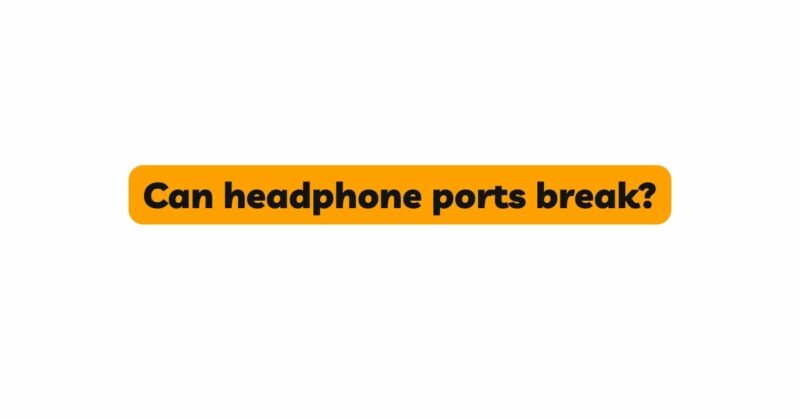Headphone ports, also known as audio jacks or headphone jacks, have been a standard feature on audio devices for decades. These small, unassuming connectors play a significant role in delivering audio from our devices to our headphones, enabling us to enjoy music, movies, and other audio content privately. While headphone ports may appear sturdy, they are not immune to breakage. In this comprehensive article, we will explore the reasons behind headphone port breakage, the common types of damage they may experience, and practical solutions to prolong the life of this crucial audio connector.
- The Anatomy of a Headphone Port
Before diving into the causes of headphone port breakage, let’s understand the basic structure of these audio connectors. Headphone ports come in different sizes, with the most common ones being the 3.5mm (1/8-inch) and 6.35mm (1/4-inch) jacks. The 3.5mm headphone port consists of three separate metal segments: the tip (left audio channel), the ring (right audio channel), and the sleeve (ground connection). When you plug in your headphones, these segments create electrical connections that allow audio signals to pass from the audio device to the headphones.
- Types of Headphone Port Breakage
Headphone ports can experience various types of breakage, each with its unique implications for audio quality and functionality:
a. Physical Damage: Physical damage occurs when the port or headphone plug is subjected to external force or pressure. This can lead to bending, cracking, or misalignment of the port, resulting in connection issues or even complete audio loss.
b. Internal Component Damage: The internal components of a headphone port, including the connectors and contact points, may degrade over time due to wear and tear. This deterioration can lead to intermittent sound, static, or audio interruptions.
c. Dust and Debris Accumulation: Dust, lint, and other debris can accumulate inside the headphone port, obstructing the contact points between the plug and the internal components. This buildup may result in audio distortion or reduced volume levels.
d. Moisture and Corrosion: Exposure to moisture or corrosive elements can cause the metal components inside the port to corrode or oxidize. This corrosion interferes with electrical conductivity and can lead to audio disruptions or complete port failure.
- Reasons Behind Headphone Port Breakage
Several factors contribute to the vulnerability of headphone ports and their potential for breakage:
a. Frequent Insertion and Removal: Repeatedly inserting and removing the headphone plug places stress on the port’s internal components. Over time, this friction can weaken the connections and make the port more susceptible to damage.
b. Aggressive Handling: Rough handling, such as forcefully inserting or removing the headphone plug, can lead to bent or misaligned port components, causing poor contact and compromised audio quality.
c. Strain on the Cable: Pulling or tugging the headphone cable, especially at sharp angles, puts strain on the cable and the port. This stress can lead to cable fraying or cause the internal components of the port to shift, resulting in malfunction.
d. Inadequate Storage: Improper storage of headphones can also lead to port damage. Coiling the cable tightly or storing headphones in a cluttered bag without protection increases the risk of breakage.
e. Environmental Factors: Exposure to environmental elements, such as moisture, humidity, and corrosive substances, can accelerate the deterioration of headphone port components.
f. Poor Quality Manufacturing: In some cases, headphone ports on low-quality or poorly manufactured devices may be more prone to breakage due to inferior materials or suboptimal construction.
- Preventive Measures
While headphone ports are susceptible to breakage, there are several preventive measures that users can take to extend their lifespan:
a. Gentle Insertion and Removal: Always insert and remove the headphone plug gently to minimize wear on the port’s internal components.
b. Proper Cable Management: Use proper cable management techniques to reduce strain on the cable and the port.
c. Use a Protective Case: When not in use, store your headphones in a dedicated protective case to shield them from external damage.
d. Regular Cleaning: Routinely clean the headphone port using a soft brush or compressed air to remove dust and debris.
e. Avoid Moisture and Liquids: Keep your headphones away from wet environments and avoid using them during activities that may expose them to sweat or liquids.
f. Invest in Quality Headphones: Choose high-quality headphones with sturdy construction and connectors to minimize the risk of port breakage.
g. Consider Wireless Options: Consider using wireless headphones to eliminate the need for a physical audio port altogether.
- Repairing a Broken Headphone Port
If your headphone port does break or become damaged, it may be possible to repair it, depending on the severity of the issue and the device’s design. However, repairing a headphone port often requires technical expertise and specialized tools, so it’s best to seek professional assistance from an authorized service center or a skilled technician.
Conclusion
Headphone ports play an integral role in our daily lives, allowing us to enjoy audio content with privacy and convenience. However, these seemingly robust connectors can be susceptible to breakage due to various factors such as frequent insertion and removal, aggressive handling, and exposure to environmental elements. By understanding the causes of headphone port breakage and adopting preventive measures, users can prolong the life of their audio jacks and continue to enjoy uninterrupted, high-quality audio experiences. Remember to handle your headphones with care, keep them clean, and store them properly to protect these essential connectors from damage.


